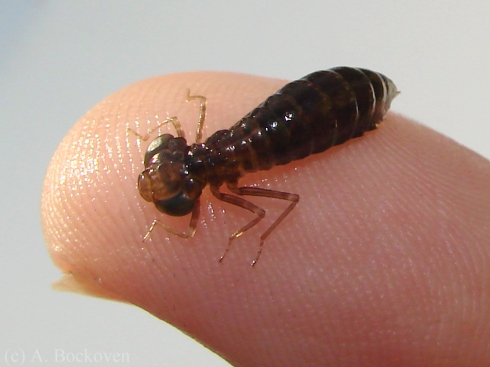
An aeshnid dragonfly nymph preys on a libellulid dragonfly nymph.
Last week I posted pictures of some dragonfly nymphs, and Jim Johnson of Northwest Dragonflier was kind enough to give me some ID tips in the comments as well as pointing out I had two different types of dragonfly larvae. Taking another look at the nymphs, the differences were not only really obvious but really interesting. So I took a bunch more pictures and made two more posts.
The two larval types I was observing belong to the dragonfly families Libellulidae (skimmers) and Aeshnidae (darners). As can be seen below, libellulid larvae have short, stout bodies with widespread legs that lend them a toad-like appearance. Aeshnid larvae have elongate, torpedo-like bodies and move about much more actively. These two body types are indicators of the two families’ very different lifestyles under the water.

Early instars of libellulid and aeshnid dragonfly nymphs (sprawlers and climbers).
Libellulid larvae are “sprawlers.” These larvae are fairly inactive, instead lurking under mud and debris at the bottom, ready to snatch potential prey that get too close. Special hairs on their body trap debris, further camouflaging them and giving them a fuzzy, almost moldy appearance. In contrast, aeshnid larvae are sleek and aggressive little predators. These “climber” larvae move rapidly through the water, actually jet-propelling their streamlined bodies by taking water in through their mouth and expelling it out their anus. Within half an hour of my moving a few nymphs into a smaller container to observe, the aeshnid pictured here had made a meal of both his libellulid tank-mates. Climber type larvae are more visually dependent than sprawlers, and their eyes tend to be larger and more developed. They also climb vegetation, moving into different water levels rather than resting on the bottom.
A few more categories exist–“clingers,” with adaptations to allow them to remain stationary in flowing water; and “burrowers,” which, as the name suggests, burrow into the mud or dirt. Aquatic insect larvae that can move freely about through the water are called “swimmers.”

An aeshnid dragonfly nymph shown on thumb for scale.
Tags: Darners, Dragonflies, Insects, Nymphs, Skimmers









Recent Comments